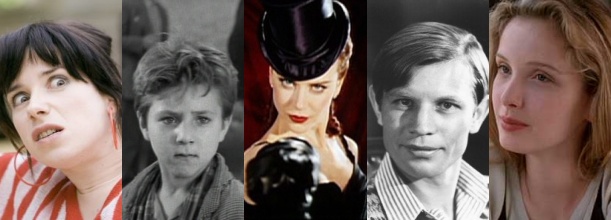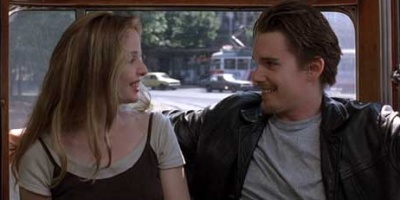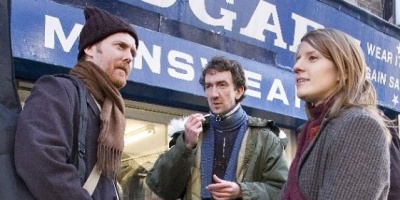Movies that define a city: Europe

Summer approaches. Stuck for where to go on holiday and want somewhere cinematic to visit? Look no further. Here are the finest films starring some of Europe’s most famous (and therefore most filmed) capital cities. (It’s just easier that way. Sorry Vicky, sorry Cristina.)
Paris
 Probably running neck-and-neck with New York as the most filmed city in the history of film, Paris also has the biggest claim to being the Global Capital of Film, if such a title exists – after all, it was there that the Lumière Brothers screened their first collection of films, and it was the base of the French nouvelle vague. It’s hosted the stylish waifishness of Audrey Hepburn (Charade) and Tom Hanks decoding Da Vinci and even had the Rugrats set free on it, but we’re not going with any of those. No, the best film set in Paris is one of that revels in the glorious decadence of a Paris that never really existed: Moulin Rouge!. Yes, Baz Lurhmann’s musical collage might be as far from a realisitic depiction of Paris as movies have ever managed. But anyone can insert a postcard shot of the Eiffel Tower into their film (which Baz does, playfully bouncing a pistol off it) – what Moulin Rouge! manages so effortlessly is to dazzle its audience with the vibrancy, the dirty glamour and the muddy perversities of Paris at the turn of the 1900s. So you can’t go there. But don’t you wish you could?
Probably running neck-and-neck with New York as the most filmed city in the history of film, Paris also has the biggest claim to being the Global Capital of Film, if such a title exists – after all, it was there that the Lumière Brothers screened their first collection of films, and it was the base of the French nouvelle vague. It’s hosted the stylish waifishness of Audrey Hepburn (Charade) and Tom Hanks decoding Da Vinci and even had the Rugrats set free on it, but we’re not going with any of those. No, the best film set in Paris is one of that revels in the glorious decadence of a Paris that never really existed: Moulin Rouge!. Yes, Baz Lurhmann’s musical collage might be as far from a realisitic depiction of Paris as movies have ever managed. But anyone can insert a postcard shot of the Eiffel Tower into their film (which Baz does, playfully bouncing a pistol off it) – what Moulin Rouge! manages so effortlessly is to dazzle its audience with the vibrancy, the dirty glamour and the muddy perversities of Paris at the turn of the 1900s. So you can’t go there. But don’t you wish you could?
Vienna
 Jesse and Celine ran into each other again in Paris, of course, but they had to be saved for this spot. Before Sunrise might well be the ideal of romance for an entire generation of hipsters – and, be honest, can you imagine a better way to fall in love than meeting an attractive stranger on a train and exploring an historic city with them? If you can, you clearly haven’t seen this. Vienna is practically a third figure in the romance here, the stone streets they visit and the people they meet shifting and facilitating the closeness of their burgeoning relationship (particularly that park). Its essential foreigness to both of them (as opposed to Celine’s intimacy with Paris in Before Sunset) draws them together, forever being emblematic of what, before the sequel, was one unforgettable night.
Jesse and Celine ran into each other again in Paris, of course, but they had to be saved for this spot. Before Sunrise might well be the ideal of romance for an entire generation of hipsters – and, be honest, can you imagine a better way to fall in love than meeting an attractive stranger on a train and exploring an historic city with them? If you can, you clearly haven’t seen this. Vienna is practically a third figure in the romance here, the stone streets they visit and the people they meet shifting and facilitating the closeness of their burgeoning relationship (particularly that park). Its essential foreigness to both of them (as opposed to Celine’s intimacy with Paris in Before Sunset) draws them together, forever being emblematic of what, before the sequel, was one unforgettable night.
Rome
 It’s in the title of Roberto Rossellini’s kickstart to neorealism, but Rome, on film at least, always feels like a very open city – the streets are wide, the buildings made of pastel-coloured stone, the skies uncluttered by metropolitan high rises or imposing hills. In Vittorio de Sica’s seminal masterwork Bicycle Thieves, this freedom of movement is both a blessing and a curse. Telling the tale of Antonio, a father struggling in post-war poverty, the film shoots Rome with the neorealists’ typical observant intimacy, never presenting the city to us but depicting the familiarity, fondness and difficulty Antonio and his son Bruno have with the spaces they search. It’s never seen as an ugly city, but neither does it fetishise sights in the vein of the Trevi Fountain in Fellini’s La Dolce Vita. It fits Antonio into the vast population, as just another story, without losing the tragic heart of his personal struggle.
It’s in the title of Roberto Rossellini’s kickstart to neorealism, but Rome, on film at least, always feels like a very open city – the streets are wide, the buildings made of pastel-coloured stone, the skies uncluttered by metropolitan high rises or imposing hills. In Vittorio de Sica’s seminal masterwork Bicycle Thieves, this freedom of movement is both a blessing and a curse. Telling the tale of Antonio, a father struggling in post-war poverty, the film shoots Rome with the neorealists’ typical observant intimacy, never presenting the city to us but depicting the familiarity, fondness and difficulty Antonio and his son Bruno have with the spaces they search. It’s never seen as an ugly city, but neither does it fetishise sights in the vein of the Trevi Fountain in Fellini’s La Dolce Vita. It fits Antonio into the vast population, as just another story, without losing the tragic heart of his personal struggle.
Bucharest
 Romanian cinema has had a famous revolution in the past seven years, producing films of such respected quality that they’ve been grouped under their own ‘New Wave’. Typically, these films are dark and minimalist, shot through with black humour – would you ever think a film where a dying man is shopped around hospitals for two and a half hours would be such a pleasure to watch? Check out The Death of Mr. Lazarescu if you find those words hard to swallow. Our choice for this trek? The Palme d’Or winning 4 Months, 3 Weeks and 2 Days, a grim drama centering on Otilia (Anamaria Marinca) setting up an illegal abortion for her friend Găbiţa (Laura Vasiliu). Finally free of Communism, Romanian cinema’s examination of its dark history is hardly going to provoke an influx of tourists, but the eerie darkness and danger of the Bucharest streets is painfully strong throughout this new set of films.
Romanian cinema has had a famous revolution in the past seven years, producing films of such respected quality that they’ve been grouped under their own ‘New Wave’. Typically, these films are dark and minimalist, shot through with black humour – would you ever think a film where a dying man is shopped around hospitals for two and a half hours would be such a pleasure to watch? Check out The Death of Mr. Lazarescu if you find those words hard to swallow. Our choice for this trek? The Palme d’Or winning 4 Months, 3 Weeks and 2 Days, a grim drama centering on Otilia (Anamaria Marinca) setting up an illegal abortion for her friend Găbiţa (Laura Vasiliu). Finally free of Communism, Romanian cinema’s examination of its dark history is hardly going to provoke an influx of tourists, but the eerie darkness and danger of the Bucharest streets is painfully strong throughout this new set of films.
Berlin
 Time for something a bit brighter. Nazis, anyone? A musical is our pick here once again; but really, is there any film more vibrantly Berlin-ian (awkward suffixes are our favourite) than Cabaret? Bob Fosse’s adaptation of the stage musical is a seminal piece of musical and sexual-political cinema which moves between the underground, dank decadence of the Kit Kat Club and the glum streets of a changing Berlin, as the liberty and camp expression of Sally Bowles (Liza Minnelli) and her set is pushed more firmly into hiding. The city of “divine decadence” that American Sally and English Brian (Michael York) have escaped to sparkles through character rather than the dull buildings around them, but the photography itself fixes a transition from bright blue skies and airy night-time freedom to a more deserted, oppressive and distant city.
Time for something a bit brighter. Nazis, anyone? A musical is our pick here once again; but really, is there any film more vibrantly Berlin-ian (awkward suffixes are our favourite) than Cabaret? Bob Fosse’s adaptation of the stage musical is a seminal piece of musical and sexual-political cinema which moves between the underground, dank decadence of the Kit Kat Club and the glum streets of a changing Berlin, as the liberty and camp expression of Sally Bowles (Liza Minnelli) and her set is pushed more firmly into hiding. The city of “divine decadence” that American Sally and English Brian (Michael York) have escaped to sparkles through character rather than the dull buildings around them, but the photography itself fixes a transition from bright blue skies and airy night-time freedom to a more deserted, oppressive and distant city.
Dublin
 Immersed in the glum reality of Dublin life, Once isn’t exactly a musical but does what the best musicals do: uses music as an uplifting force on its characters. Not just emotionally, but literally: the music is their way out of poverty. The characters don’t really view Dublin as a desirable place to be living – Hansard is encouraged to follow his ex-girlfriend to London – and the naturalistic photography films the city as a grey, faded locale, but there’s a naked truth to their performances that seems informed by the simplicity of the worn city in which they live. Multicultural Dublin isn’t a unified city but an inclusive, welcoming shelter for the troubled and the lonely where two strangers can make a meaningful connection.
Immersed in the glum reality of Dublin life, Once isn’t exactly a musical but does what the best musicals do: uses music as an uplifting force on its characters. Not just emotionally, but literally: the music is their way out of poverty. The characters don’t really view Dublin as a desirable place to be living – Hansard is encouraged to follow his ex-girlfriend to London – and the naturalistic photography films the city as a grey, faded locale, but there’s a naked truth to their performances that seems informed by the simplicity of the worn city in which they live. Multicultural Dublin isn’t a unified city but an inclusive, welcoming shelter for the troubled and the lonely where two strangers can make a meaningful connection.
London
 For our homecoming, we’re not singling out a particular film, but a particular filmmaker. Is there anyone who captures everyday London life better than Mike Leigh? As with Rossellini’s Rome, Leigh’s London (how’s that for alliteration) unfolds not through picturesque postcard photography but through the characters’ experience of it, using the city’s particularities as a backdrop and an influence on their activities. Picture Eddie Marsan directing Sally Hawkins’ learner driver along thin suburban lanes. Or Marianne Jean-Baptiste meeting her birth mother Brenda Blethyn outside Holborn tube. Or Jim Broadbent buying a delapidated snack van in a smoking scrapyard. Leigh is far from capturing cosmopolitan inner-city London life; his observational, improvisational style captures the mundane, the bright but glum surroundings, and the often lazy, often ugly, but always well-meaning sentiment of people trapped on the edge of money and in the bosom of family.
For our homecoming, we’re not singling out a particular film, but a particular filmmaker. Is there anyone who captures everyday London life better than Mike Leigh? As with Rossellini’s Rome, Leigh’s London (how’s that for alliteration) unfolds not through picturesque postcard photography but through the characters’ experience of it, using the city’s particularities as a backdrop and an influence on their activities. Picture Eddie Marsan directing Sally Hawkins’ learner driver along thin suburban lanes. Or Marianne Jean-Baptiste meeting her birth mother Brenda Blethyn outside Holborn tube. Or Jim Broadbent buying a delapidated snack van in a smoking scrapyard. Leigh is far from capturing cosmopolitan inner-city London life; his observational, improvisational style captures the mundane, the bright but glum surroundings, and the often lazy, often ugly, but always well-meaning sentiment of people trapped on the edge of money and in the bosom of family.





Recent Comments